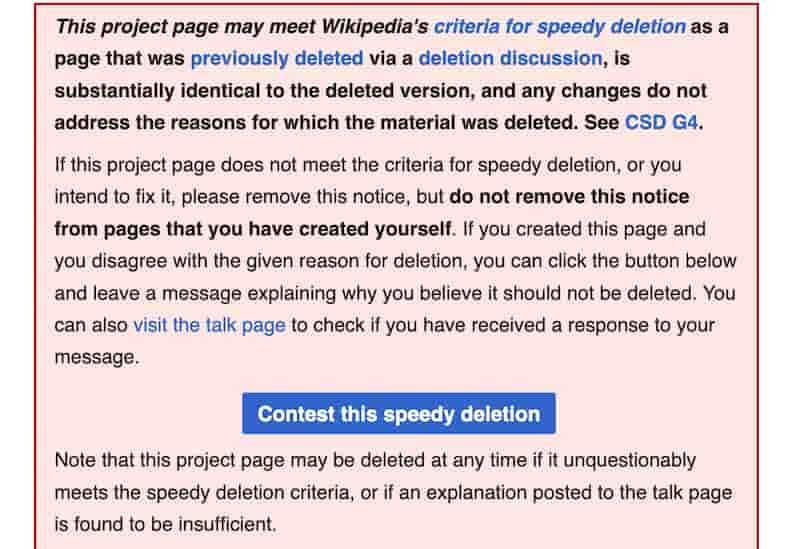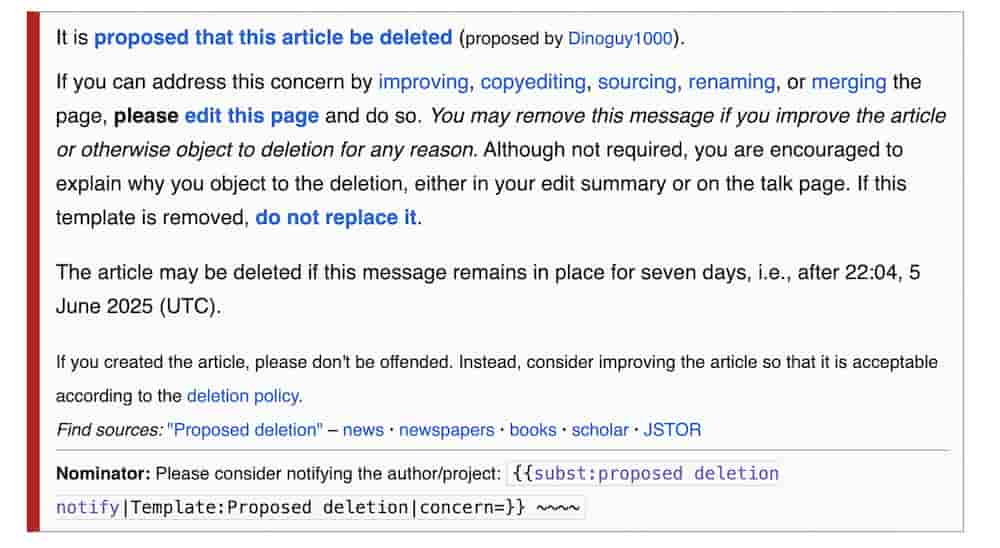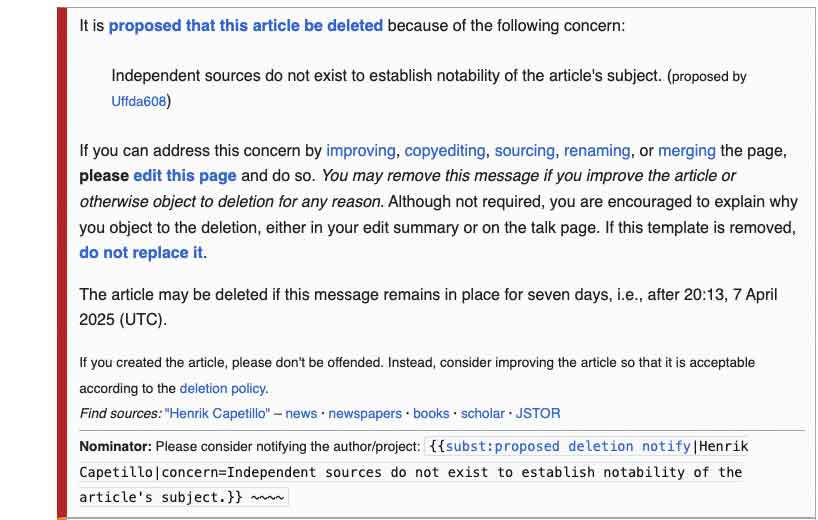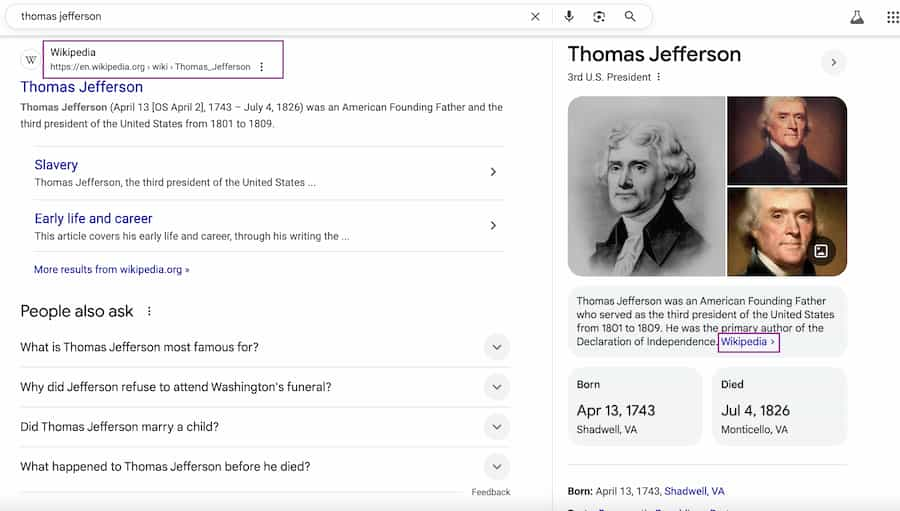The Guide to Wikipedia Article Deletion & Maintenance

Wikipedia is more important to brands today than ever. It informs Google Knowledge Graph (and therefore Google Knowledge Panel), AI search, and it usually ranks on the first page of search results for the article’s subject. Between Wikipedia’s strict notability guidelines, community-driven moderation, and rather intense deletion policies, keeping your page alive can feel like a full-time job. Understanding these nuances is a good idea if you want to protect one of your brand’s most visible online assets.
In this guide, we’re breaking down the often-murky world of Wikipedia article deletion and maintenance and how to deal with issues in the real-world editing environment of Wikipedia. Whether you’re trying to save a page on the brink of removal, decode cryptic editor comments, or fortify your page from future challenges.
TL;DR
- It isn’t your page. We’re going to say “your page” a lot in this article, but it’s not really yours. It’s more like “ours,” in the sense that the Wikipedia community decides the fate of the article. But you do have a say, often a strong one.
Wikipedia’s rules aren’t just guidelines—they’re the DNA of the platform. To keep your page safe from deletion, you’ll need to understand the why behind Wikipedia’s strict policies. Notability and reliable sourcing are non-negotiable; they’re the cornerstones editors use when deciding what stays or goes. Missing the mark here is like building a sandcastle too close to the tide—one wave, and it’s gone.
Not all deletions are created equal. Wikipedia uses different processes to handle page removal: speedy deletion for obvious violations, proposed deletion for low-risk issues, and Articles for Deletion (AfD) debates where the community decides a page’s fate. Knowing how each works will help you react swiftly and effectively when your page is on the line.
Contesting a deletion requires strategy. A weak argument full of opinions won’t get you far in the AfD process. Instead, you’ll need to make a case based on facts, guidelines, and collaboration with editors. Think of it less like a debate and more like convincing a jury—evidence and approach count for everything.
Maintenance is your best defense. A neglected Wikipedia page is a prime target for deletion or vandalism. Regular updates, proactive monitoring, and addressing red flags like unsourced claims or biased language will go far keeping your page online and credible.
The Talk Page is a secret weapon for collaboration. While it might seem like a behind-the-scenes feature, the Talk Page is where the magic (or let’s be honest–drama) happens. Engaging constructively with editors here can be the difference between saving your page or losing it. Approach these conversations with curiosity and respect—you want allies, not adversaries.
Preparation beats panic. Always. Whether you’re drafting a new page or managing an existing one, understanding the risks of removal and building your page with those in mind is much easier than trying to rescue it after it’s flagged. Think of it as building a house—you wouldn’t start without a blueprint and solid foundation.
Avoid self-promotion like a plague. A well-maintained Wikipedia page can elevate your brand’s reputation and keep facts straight in search, but the real goal is to create something that aligns with Wikipedia’s purpose: to inform, educate, and serve the public. When you focus on contributing value rather than self-promotion, your page gains the kind of legitimacy that stands the test of time.
By mastering Wikipedia’s policies and leveraging its tools, you’ll not only safeguard your page but also strengthen your organization’s digital credibility. Let’s dive into the nuts and bolts of how Wikipedia’s deletion and maintenance ecosystem works—you’ll come away ready to navigate even the trickiest situations.
Why Was Your Wikipedia Page Deleted?
Navigating Wikipedia’s article deletion policies can feel a bit like deciphering Egyptian hieroglyphics. Deletion policies are supposed to be about maintaining the quality, credibility, and neutrality of the platform–and they mostly are. Think of it this way: Wikipedia isn’t just an open encyclopedia; it’s a curated collection of knowledge. Every article is meant to serve a purpose, whether it’s informing, educating, or documenting—not promoting, speculating, or misleading. The volunteers who are patrolling pages for deletion are performing a valuable service.
One of the first things to understand is that Wikipedia’s deletion system isn’t arbitrary. Articles don’t usually just disappear because one editor takes issue with them, although one powerful editor can be a problem and may delete your page unilaterally. Normally, the process is driven by established guidelines and community consensus. These guidelines help determine whether an article belongs on the site and whether it adheres to the broader principles of verifiability, notability, and neutrality. This is one of the reasons brands consult with Wikipedia editing specialists.
Lack of Notability Can Trigger Deletion
For instance, let’s say you’ve come across an article that’s newly flagged for deletion. If the topic doesn’t meet Wikipedia’s notability standards, meaning it hasn’t received significant coverage from reliable sources, that’s often a red flag. An example might be a page about a local coffee shop that hasn’t been profiled by any major publications and instead relies solely on sources like the shop’s website or social media posts. You might think it might seem relevant to a small audience, but without independent and verifiable coverage, it won’t meet Wikipedia’s inclusion criteria. That makes it ripe for deletion.
How It’s Written Can Trigger Deletion
Another key point is that deletion policies aren’t just about what’s written—they’re about how it’s written, too. Articles that read like advertisements or press releases, for example, are often flagged. At Reputation X, we are often asked to help with situations where a brand manager unwisely edited their company Wikipedia article and added awards, non-neutral language, or links to promotional material–and got their page either slapped or deleted. Wikipedia has a strict stance against promotional language, relying instead on a neutral tone that avoids exaggerations or marketing jargon.
Deletion discussions often bring together editors from wildly diverse perspectives, debating everything from the reliability of sources to the article’s overall relevance. A healthy discussion might balance someone advocating for the broader public interest while another zooms in on nuanced policy interpretations. Conversely, a compromise is reached where no one is really happy. If you’re watching from the sidelines, these debates offer a window into Wikipedia’s commitment to transparency and community-driven decision-making.
Deletion As a Last Resort
At the same time, editors often view deletion of an ‘on the fence’ article as a last resort. Wikipedia strives to improve good articles rather than remove them outright. If an article has potential but falls short—for instance, it needs better sourcing or rewording to be more encyclopedic—editors might propose improvements instead of immediate deletion. That’s why it’s a good idea to look at the feedback accompanying deletion tags. Frequently, these notes provide actionable suggestions to salvage the page, if you are fast enough.
So, while the phrase “deletion policies” might be intimidating, think of it as a quality control framework. It’s less about erasing content and more about aligning it with Wikipedia’s mission of providing reliable, neutral, and well-sourced information to readers worldwide.
How Wikipedia’s Internal Dynamics Shape Deletion Outcomes
Most people assume Wikipedia is an impartial encyclopedia — follow the rules, cite your sources, and your article will be fine. In reality, Wikipedia’s editorial decisions are shaped by complex internal politics, social hierarchies, and bureaucratic processes that often defy logic.
Understanding these dynamics can help you keep an article from being deleted — or restore one that was.
Wikipedia Isn’t a Democracy, It’s a Bureaucracy
While anyone can edit Wikipedia, a small number of experienced users (admins and long-time editors) wield disproportionate power over deletion outcomes.
- Articles nominated for deletion often go to an “AfD” (Articles for Deletion) discussion.
- Consensus isn’t decided by vote count, but by arguments made — and who makes them.
- A well-argued comment from a long-time editor carries more weight than multiple objections from newcomers.
The result: Deletion discussions often reflect entrenched views rather than objective policy.
Meet the Wiki-Cliques (a.k.a. “The Cabal”)
Though satirical in name, many editors refer to tight-knit groups of influential Wikipedians as “The Cabal.” These are informal networks of admins, bureaucrats, and editors who:
- Watch over specific article categories (e.g., biographies, politics, medicine).
- Patrol for conflict-of-interest (COI) editing or vanity pages.
- Push for stricter interpretations of notability in certain topics (e.g., startups, crypto, minor celebrities).
They often initiate deletions preemptively — sometimes within hours of article creation.
A good article in the wrong neighborhood (e.g., BLP: Biographies of Living Persons) can attract deletion even if it meets guidelines.
If your Wikipedia page is under scrutiny, you’re not just fighting policy — you’re navigating a complex web of editor politics, social hierarchies, and interpretive gray zones. Knowing how to participate in deletion discussions — or enlisting an experienced Wikipedia advocate — can be the difference between visibility and vanishing.
How to Prevent Deletion Before it Happens
When it comes to removing content, Wikipedia has built a loose process that reflects its foundational principle of collaborative editing. It’s not a free-for-all but rather an agreed to approach to balance the platform’s openness with the need to maintain quality and integrity. If you’ve ever wondered why some articles disappear almost overnight while others linger for lengthy discussions, it boils down to the type of deletion process involved. Let’s break this down into the three main mechanisms: Speedy Deletion, Proposed Deletion (often called PROD), and Articles for Deletion (AfD).
| Deletion Type | Who Can Initiate It? | Discussion Required? | Timeframe Before Deletion | Can It Be Contested? | Typical Use Cases |
|---|---|---|---|---|---|
| Speedy Deletion (CSD) | Admins (based on clear policy criteria) | ❌ No | Immediate or within hours | ✅ Yes, but must act fast | Spam, vandalism, test pages, empty articles |
| Proposed Deletion (PROD) | Any editor | ❌ No (unless contested) | 7 days | ✅ Yes, simply remove the PROD tag | Marginal topics, articles with weak sourcing |
| Articles for Deletion (AfD) | Any editor | ✅ Yes (community debate) | ~7 days (discussion closes, may extend) | ✅ Yes, through active debate or appeal | Notability disputes, conflict of interest, biased tone |
Speedy Deletion
Speedy Deletion is exactly what it sounds like—a fast, no-frills way to remove content that clearly violates Wikipedia’s policies. This isn’t about trivial disagreements; it’s for cases where the issues are obvious. Think of an article that’s pure spam, a blatant ad, or content that’s a test page mistakenly submitted as a real one. Speedy Deletion can also apply to pages that are unsalvageable because they completely fail Wikipedia’s core guidelines, like an “article” that’s just a single sentence devoid of context. Editors or admins reviewing these cases rely on a set of well-defined criteria known as the “CSD” list (Criteria for Speedy Deletion) to determine eligibility for this process. The efficiency comes from skipping prolonged discussions, but there’s one catch—you have to act quickly if you believe a speedy deletion was unwarranted. Once the page is gone, reinstating it is a more complicated process requiring admin intervention.

Proposed Deletion
Proposed Deletion, or PROD, works as the next layer of the deletion process. It’s a bit like tagging something as “up for review” but without the rush of Speedy Deletion. It’s used for articles that are problematic but not urgently so—maybe they’re poorly sourced, non-notable, or just sitting in a gray area where their purpose isn’t entirely clear. What makes PROD unique is the built-in grace period: editors have seven days to either fix the issues or contest the deletion. If nobody objects or addresses the concerns in that window, the article is quietly removed. The beauty of PROD lies in its simplicity—it’s non-confrontational and allows the Wikipedia community to self-regulate without drawn-out debates. However, once contested, the PROD tag can’t be re-applied, meaning the article has to either stand as is or move into more formal channels like AfD.

Articles for Deletion (AfD)

Speaking of Articles for Deletion (AfD), this is where things get a bit more dynamic. AfD is essentially a community discussion—a democratic process where editors weigh in on whether an article should stay, be merged, or be deleted. It’s the go-to route for cases that aren’t clear-cut, where notability or source quality is up for debate.
AfD discussions typically last about seven days, and during that time, anyone with a Wikipedia account can chime in. Editors present arguments grounded in policies like verifiability, neutrality, and reliable sourcing. Expert editors often cite specific rules. In practice, though, debates can be, well… spirited, with contributors often bringing in a mix of policy references and their own personal opinions. If you want to see AFD in action, look at the Talk page of most lesser-known cryptocurrency Wikipedia articles. Some editors just hate crypto. The decision isn’t based on votes per se but rather a consensus among participants, determined by an admin who reviews the discussions. What makes this process valuable—and occasionally frustrating—is that it forces editors to collaboratively consider multiple viewpoints before reaching a resolution.
What to do After a Deletion
When you find out that a Wikipedia article is at risk of deletion, it can feel a bit like stepping into an unexpected debate where the stakes are high. If your page gets deleted it can take a lot of things down with it–like Knowledge Panels.

Contesting a deletion effectively is less about reacting emotionally and more about presenting a solid, well-supported case that aligns with Wikipedia’s guidelines. It’s a process that rewards preparation, collaboration, and a clear understanding of policy.
At the heart of this process is knowing how to communicate the value and viability of the article in question. Wikipedia isn’t supposed to be driven by personal opinions; every argument should center around its core pillars—like notability, verifiability, and neutrality. Let’s tackle this step-by-step.
Preparing a Strong Case to Contest Deletion
First things first: revisit the article. Review the content critically, as if you’re a neutral third party, and ask yourself—does this article truly meet Wikipedia’s standards? Specifically, the notability of the subject is often where debates spark. You’ll want to gather reliable, third-party sources (think coverage in established newspapers, industry publications, or academic journals) that demonstrate the subject’s significance. Make sure these sources are independent of the subject—self-published content or anything overtly promotional won’t strengthen your case.
Note: You don’t have a lot of time to prepare your case. If you can, do it in one day because Wikipedia articles can be deleted quickly and it’s a real challenge to bring them back from the dead.
Next, identify the specific reasons listed in the deletion proposal. Whether it’s a question of notability, a lack of reliable sources, or perceived promotional language, tailor your response to directly address these concerns. For example, if the deletion notice claims insufficient references, your strategy should focus on incorporating high-quality sources into the article and citing them appropriately. Avoid being defensive—it’s all about showing how the article aligns with Wikipedia’s standards, not debating in a vacuum. Keep in mind that if editors find out you are the subject of the Wikipedia article, or represent the subject of the article, you may be seen in a less favorable light.
Take a moment to summarize your case concisely, presenting objective reasons for why the article should be retained. A good rule of thumb? Think evidence and policy over passion. Statements like “The subject clearly meets Wikipedia’s notability requirements, with five independent and reputable sources documenting substantial coverage over a 10-year period” will get you much further than “This is important to me, and it’s unfair to delete it.”
Navigating the AfD Process
When an article is listed for Articles for Deletion (AfD), things can seem a little overwhelming at first glance. AfD discussions are community-driven debates where contributors review arguments made for and against keeping an article. It’s important to engage in these discussions thoughtfully and respectfully.
Start by contributing your input in the AfD discussion thread—this is where your prepared case comes into play. Clearly outline why the article meets Wikipedia’s policies, pointing to specific guidelines or criteria as you make your argument. Use links to policy pages or established content guidelines to back up your points; this shows you understand the framework within which Wikipedia operates. For example, if you’re arguing notability, reference the specific guidelines outlined in Wikipedia’s General Notability Criteria.
Try to be nice
It’s equally important to avoid overly aggressive or combative language during these discussions. Raising your voice (figuratively) doesn’t win points here. Instead, approach the dialogue with a collaborative mindset. If someone opposes your argument, it’s okay to politely clarify your position or provide further evidence, but don’t get drawn into personal disputes—they’ll only weaken your credibility.
Bear in mind that consensus doesn’t mean a direct vote. Even if the numbers in the AfD comment thread seem skewed one way, the closing administrator will use the strength of the arguments—rooted in Wikipedia policy—to make their decision. This is why the quality of your case is far more influential than the quantity of supporters.
Tips for Collaborating With Wikipedia Editors
Work with Other Editors
Contesting deletion is rarely a solo effort, and working effectively with other Wikipedia editors can make all the difference. If your article has collaborators or contributors, reach out to them for support. They may have additional sources, insights, or arguments to strengthen your case. Collaboration shows good faith and reinforces that the effort is about improving Wikipedia’s knowledge base, not just “saving” an article.
Listen for Clues
When editors critique or provide feedback during the deletion process, listen carefully. While it can be frustrating to hear suggestions that feel like roadblocks, many editors are genuinely trying to help align the article with Wikipedia’s standards. Some editors certainly do have personal agendas though. Responding positively and implementing constructive suggestions demonstrates your commitment to creating quality content aligned with community expectations.
Remember the Talk Page
If you need to explain complex updates or are seeking input on significant revisions, the Talk page offers an informal space to collaborate without derailing the formal AfD thread.
In the end, contesting Wikipedia article deletion is all about blending preparation with diplomacy. By staying rooted in the policies, keeping the conversation cooperative, and working toward the best possible version of the article, you’re not just advocating for your page—you’re contributing to the integrity of Wikipedia as a whole.
How to Protect Your Wikipedia Page from Deletion or Vandalism
What if you’re just not sure whether an article you care about might be deleted or not?
When it comes to safeguarding a Wikipedia page, the first and most basic thing to understand is that Wikipedia is an open ecosystem. Anyone can edit most pages depending on their level of protection, which is both the platform’s strength and its Achilles’ heel. That openness fosters collaboration and transparency but also invites risks—whether those are misguided edits, deliberate misinformation, or deletion threats. Fortunately, there are steps you can take to minimize these risks and ensure your page’s stability.
Deletion vs Vandalism
Let’s start with the two primary issues: deletion and vandalism. While deletion is often triggered by questions about a page’s notability or adherence to Wikipedia’s guidelines, vandalism generally involves bad-faith edits that can range from adding false information to outright page defacement. Addressing these effectively requires a proactive approach.
Vandalism, while frustrating, usually follows predictable patterns. For example, high-profile individuals or controversial topics often attract more disruptive edits. You will often see their pages have been “protected”. If your page falls into one of these categories, implementing tools like ClueBot (a widely used anti-vandalism bot) can help flag suspicious edits for review. Wikipedia editors and contributors often work together through projects like the “Counter-Vandalism Unit,” making it possible to report recurring issues if you feel overwhelmed.
Sources Are Like Armor
First, build a strong foundation for your page. If your page is well-sourced, meticulously written, and adheres to Wikipedia’s notability and neutrality guidelines, it’s much harder to justify deletion. Make sure every claim is backed by reliable, secondary sources—not press releases or self-published content, but well-regarded news outlets or academic references. Think of it this way: the better your sources, the stronger your page’s armor.
Skip Your Own Sources
Now, you might wonder, “How do I know which sources are reliable?” A good rule of thumb is to avoid sources where you—or the subject of the article—might have undue influence. For example, while company blogs or promotional materials might seem tempting, they’re generally frowned upon. Instead, rely on independent publications with editorial oversight. Practically speaking, a well-referenced page acts as a deterrent to both deletion proposals and casual vandalism. Editors and admins are less likely to target a page they perceive as thoroughly compliant with Wikipedia’s standards.
Monitor So You Know About Pending Deletion
Once your page is live, monitoring becomes your next line of defense. Wikipedia offers tools like the “Watchlist,” which allows you to track edits in real time. You can activate this by simply clicking the star icon at the top of the page when you’re logged in to Wikipedia. But don’t just monitor passively—stay engaged. If you notice problematic edits, particularly ones that seem to compromise the content’s neutrality or factual accuracy, address them promptly as a neutral third-party. Wikipedia has built-in options to undo such changes, but always leave an edit summary explaining why you made a reversal. Clear communication not only resolves issues faster but also signals to other editors that you’re maintaining the page responsibly.
Dealing with Disruptive Edits
Still, even with vigilant monitoring, you may encounter more persistent issues, like disruptive edits from unregistered accounts or anonymous users. In these situations, consider requesting page protection. Page protection levels on Wikipedia can restrict who can edit a page, from blocking anonymous users to “semi-protecting” or “fully protecting” a page against all but trusted contributors.
To request this, use Wikipedia’s “Requests for Page Protection” process, explaining why you believe restrictions are necessary. For example, ongoing vandalism or repeated removal of sourced content can often justify such measures. While these protections are rarely permanent, they can act as a temporary shield during periods of heightened activity.
Again we come back to the “Talk” page associated with every Wikipedia entry. The Talk page isn’t just a backend discussion forum; it’s a great collaborative tool where editors debate changes, clarify interpretations of guidelines, and resolve disputes. Engaging here can help prevent disputes or deletion discussions down the line, as active participation demonstrates your commitment to transparency and collaboration.
People do read your contribution history and having a deep one gives you street “cred”. If you’re unsure how to contribute effectively, start by asking questions or seeking consensus on questionable edits rather than imposing unilateral changes. This builds trust within the Wikipedia community.
No matter how secure your page seems, remember that Wikipedia thrives on community oversight. Stay active and lean into Wikipedia’s collaborative ethos by working alongside other editors rather than against them.
How to Maintain and Protect a Wikipedia Page
Creating a Wikipedia page is an achievement in itself, but the real challenge lies in keeping it accurate, updated, and protected. Wikipedia isn’t a static platform—it thrives on constant collaboration and vigilance. The more well known the subject, the more edits it will attract. The moment a page goes live, it’s part of a dynamic ecosystem with contributions and changes from editors worldwide. To ensure your page stays up and continues to reflect credibility, you’ll need to adopt a proactive approach.
Double-Check References
One of the first things to focus on is properly establishing the credibility of your page right after creation. That is, double-check. Take a moment to review the references included. Are they balanced, well-sourced, and reliable? If the sources predominantly come from press releases or promotional materials, the page may be flagged for a lack of neutrality, especially if the article is young. It’s absolutely worth going the extra mile to incorporate citations from independent, high-quality publications that are not on what we at Reputation X call the “naughty list”.
Maintain Vigilance
Once a page is stable, maintenance needs to become part of the routine. Think of a Wikipedia page like tending a garden—it doesn’t need constant attention, but neglect can lead to weeds in the form of outdated information or, worse, misinformation. The more controversial the subject or industry, the more attention the page will require.
Tip: Set a reminder to review the page every few weeks even if you have monitoring turned on, or after a significant development related to the subject of the page. This gives you an opportunity to update data, improve clarity, or address any inaccuracies before they snowball into bigger issues.
Although Wikipedia is built on collaboration, not everyone who edits your page may have good intentions—or expertise. As mentioned above, tools like the “Watchlist” feature allow you to track changes in real-time. Whenever someone makes an edit, you’ll receive a notification to review it. It’s a straightforward way to separate well-meaning editors from vandals or those inserting biased perspectives. Quick response times are super important here—addressing questionable edits promptly reduces the chances of misinformation spreading or unnecessary disputes arising.
Be a Part of the Community
Beyond routine updates, one of the smartest things you can do is actively engage with the Wikipedia community well before there is an issue. If someone raises concerns about your page on the “Talk” section, take the time to address them thoughtfully. Genuine collaboration with editors can go a long way toward protecting the integrity of your page. When editors see that you’re willing to work within Wikipedia’s guidelines rather than pushing an agenda, they’re more likely to support your page and even assist in improving it.
Maintaining a Wikipedia page requires a blend of vigilance, collaboration, and respect for the platform’s rules. It’s not about “ownership” of the page—Wikipedia “owns” the page—but about stewardship. By investing time into the care and security of a page, you’re not only protecting its existence but ensuring that anyone who stumbles across it finds accurate and credible information.
How to Monitor and Manage Wikipedia Page History Effectively
Wikipedia meticulously logs every single edit made to an article—whether it’s a minor tweak or a complete overhaul. Understanding how to monitor and manage this dynamic record is not just a technical skill; it’s a strategy for protecting your article’s credibility and ensuring that its content tells an accurate story over time.
Reading the Ledger
A Wikipedia page’s history is a detailed ledger of who changed what, when, and often gives their reasons for doing so. But beyond serving as an archive, this feature is a treasure trove of insight. For instance, routinely scanning the edit history can help you spot trends—maybe there’s a recurring vandal targeting the page, or perhaps a well-intentioned but inexperienced editor keeps reintroducing inaccuracies. By keeping an eye on these patterns early on, you can address potential issues before they snowball into bigger problems that tarnish the page’s integrity.
Once you add a page to your Watchlist (click the star in the upper corner), you’ll receive notifications about every change made to it, highlighting even the smallest updates. Of course, if you’re monitoring multiple pages, it’s easy for notifications to pile up—so setting priorities is something you will want to do. Many subjects have over a dozen off-shoot articles supporting them.
Aftermath of Significant Edits
Managing the aftermath of significant changes is where things get interesting. Let’s say someone introduces an edit you strongly disagree with—what do you do? The first step is to pause and evaluate. Look at the edit comment (those small notes editors often write to explain their changes) and see if it provides context. If the edit violates a Wikipedia policy, you can usually revert it without hesitation. That’s as simple as clicking the “Undo” button next to the edit in question.
However, in cases where the intent behind the edit is unclear or seems well-meaning, it’s better to open a dialogue on the Talk page. This is especially true with really powerful and experienced Wikipedia editors with aggressive agendas. Drop a comment on the page’s Talk section and invite the editor to explain their perspective so everyone else can understand it too.
Edit Conflicts
Another frequent challenge is handling edit conflicts—situations where two editors try to make updates at the same time, leading to overlapping changes. Wikipedia’s interface does its best to warn you when edit conflicts occur, but to successfully navigate them, you’ll need to establish a process for resolving discrepancies amicably. Acknowledge the other editor’s contribution, highlight parts of their changes that align with Wikipedia’s guidelines, and work towards an integrated version that respects both perspectives.
Lastly, for those managing high-profile or controversial pages, advanced tools like ClueBot NG or XTools can be game-changers. These programs dive deeper into metrics surrounding edit activity, such as identifying potential sockpuppets (fake accounts used to manipulate content) or naming the most active contributors on the page. Armed with these insights, you can better anticipate potential disruption and proactively mitigate issues.
Additional Best Practices for Wikipedia Article Maintenance
Maintaining a Wikipedia article isn’t just about reacting to edits or keeping an eye out for potential issues; it’s about fostering a proactive and collaborative environment. One of the most underrated, yet highly effective strategies lies in building positive relationships with Wikipedia moderators. Think of them as the gatekeepers to the platform—they’re volunteers who play a pivotal role in upholding Wikipedia’s standards. By treating their feedback as constructive rather than adversarial, you can establish yourself as a collaborator rather than someone merely pushing an agenda.
For example, if a moderator flags an issue on your article, respond promptly and professionally on the corresponding Talk Page. A polite query asking for clarification or offering additional sources to support the content signals your commitment to following Wikipedia’s guidelines. This rapport can go a long way in easing future interactions and avoiding potential disputes. I
Another non-negotiable habit is staying aware of Wikipedia’s evolving policies. Rules around notability, sourcing, and neutrality are continually updated to reflect the platform’s growing complexity, and what might have been an acceptable practice a year ago could now put your article at risk. With all of the AI tools coming to light every day, the job of patrolling Wikipedia gets more and more complex, so change becomes more frequent.
You might consider getting into the habit of checking Wikipedia’s policy pages and editor forums regularly. If staying on top of granular policy updates feels overwhelming, focus on changes most relevant to your type of content. For instance, if your article involves a business or public figure, prioritize updates around notability criteria and reliable sources. Many long-term contributors also participate in webinars or community discussions, often hosted by Wikipedia-affiliated organizations. These forums can offer invaluable insight into emerging trends and challenges, arming you with the knowledge to keep your article compliant over the long term.
Common Challenges and How to Overcome Them
Navigating Wikipedia’s landscape has its hurdles. Whether you’re safeguarding a page from malicious edits or addressing misapplied deletion policies, the challenges can sometimes feel relentless–especially if you are trying to shield an article from haters. Let’s look at some of the most common issues and how you can tackle them effectively.
Take persistent vandals, for example. If you’ve ever encountered a scenario where the same individual—or group of individuals—keeps reverting edits, inserting false information, or outright defacing a page, you know how frustrating this can be. Wikipedia has mechanisms in place to help mitigate vandalism, but it requires vigilance on your part. Keep an eye on the page’s edit history; it’s your most valuable tool for spotting patterns of disruptive behavior. Once you’ve identified consistent issues, don’t hesitate to report the vandalism to Wikipedia administrators.
Misuse of Deletion Policies
Then there’s the misuse of deletion policies, a challenge that can catch even the most well-intentioned contributors. It might be that someone flags your article for deletion with claims that don’t align with Wikipedia’s guidelines. When this happens, the key is to stay composed and approach the situation methodically. First, review the specific deletion rationale. Is it based on claims of insufficient notability? Maybe it’s questioning the reliability of your sources? In any case, respond with substance – not emotion. Provide clear evidence supporting the article’s compliance with Wikipedia’s policies—this could mean linking to third-party coverage, authoritative references, or demonstrating the subject’s cultural relevance.
One of the trickiest situations arises when you’re toeing the line between advocacy and neutrality, particularly if you’re deeply invested in the page topic. Wikipedia’s core policy of neutrality doesn’t leave much room for embellishment or promotional language. Yet, it’s not uncommon for passionate editors to inadvertently lean too far into persuasive territory. The solution? Step back and evaluate whether the tone and content stick purely to the facts.
- Check the Deletion Log: Your first step is to determine why and by whom the page was deleted. Visit the deletion log and enter the exact name of the page in the “Target” field to find relevant details.
- Contact the Deleting Administrator: If the deletion reason is unclear or you have concerns, consider reaching out directly to the admin who performed the deletion. You’ll see their username in the deletion log. You can leave a message on their talk page to discuss the matter.
- Request Un-deletion: If, after reviewing the deletion reason, you believe the page should be restored, you can formally request un-deletion. Visit Wikipedia:Requests for un-deletion and provide a clear rationale for why the page should be restored. It’s a good idea to include any new information or reference sources that address the original reasons for deletion.
- Escalate: If the un-deletion request is denied or if you believe the deletion was improper, you can take the issue to Wikipedia:Deletion review. Here, the community will re-examine the deletion decision. Provide a concise explanation of why you believe the deletion was incorrect, referencing relevant policies or guidelines.
Tip: Before you contact the Admin, pretend you’re an entirely uninvolved reader encountering the page for the first time. Does everything read objectively, or does it stray into opinionated phrasing? When in doubt, crowdsource feedback from other experienced editors. That’s what we do at Reputation X, we call it our peer-review team Their insights can help you refine the balance between presenting information compellingly and maintaining the impartiality that the Stormtroopers of Wikipedia aim for.
Conclusion
Wikipedia may feel like a daunting labyrinth, and frankly it is, but for those tasked with shaping a brand’s presence, it offers an opportunity to contribute meaningfully to the public’s understanding of your organization. When managed thoughtfully, it’s more than just a page—it’s a testament to your brand’s credibility and relevance on the global stage. Engaging with the platform on its own terms, grounded in notability, neutrality, and collaboration, is how you not only sustain your presence but build something lasting.
Tags: Wikipedia, Wikipedia Writing.
